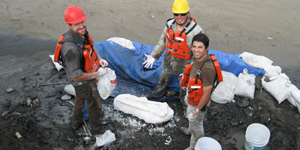by Aaron Wood
There are many important lessons to be learned as a new transplant in Panama. First, when speaking Spanish, pay attention to your vowels. Otherwise, you may find yourself on a very interesting taxi ride after forgetting whether “Turn right” translates to “Vaya derecha” or “Vaya derecho.” Second, the car horn is a versatile tool for conveying complex inter-vehicular messages, most important of which that I usually hear from other drivers, is, “Pardon me, but I am driving in a potentially unsafe manner. I just wanted you to know that.” Finally, one quickly learns that a day at the beach is not necessarily relaxing and may require the use of powered rock saws, especially when one is trying to complete a trench before the tide comes in.

My post-doctoral position with the PCP-PIRE project requires me to spend a substantial amount of time in Panama, rescuing fossil resources from the Canal Zone and elsewhere, working closely with researchers and interns at the Smithsonian Tropical Research Institute (STRI) and participating in outreach programs to Panamanian college students. In addition, working with PCP-PIRE is a great chance for me to gain a perspective from tropical paleofaunas on how mammalian communities and lineages adapted to various paleoenvironments in the geologic past.
My three months in Panama have been an enriching and exciting experience. I have seen beautiful landscapes and shorelines on various multi-day field excursions, interacted with folks from all over Central and South America and watched student enthusiasm for biology and paleontology grow during a workshop at the Universidad Autónoma de Chiriquí. As for research, I am particularly excited about the results of two large-scale excavations of stunning fossil marine animals. These specimens are likely to have major implications for the evolutionary histories of their respective taxonomic groups as well as implications for how paleoenvironments changed as the Isthmus of Panama developed. There will be more on that later.
In addition to learning more of the somewhat humorous lessons as described above, I am convinced that my international experience in PCP-PIRE will continue to be one of the most important educational opportunities of my career. I am grateful to my colleagues in PCP-PIRE and STRI for providing me with this opportunity and look forward to broadening my research, educational and cultural interests over the next two years.
por Aaron Wood
Hay varias lecciones importantes que aprender como recién llegado a Panamá. Primero, cuando hable Español, ponga atención a las vocales. De lo contrario puede encontrarse en una situación muy interesante si en un taxi se le olvida si “Turn right” se traduce “Vaya a la derecha” o “Vaya derecho.” Segundo, la bocina del carro es una versátil herramienta para comunicar mensajes inter-vehiculares complejos, siendo el más importante el que escucho casi siempre: “Perdón, pero estoy conduciendo de una forma potencialmente peligrosa. Solo quería que lo supiera”. Finalmente, uno aprende rápido que un día en la playa no es necesariamente relajante y puede requerir el uso de potentes sierras, especialmente cuando uno está tratando de terminar una zanja antes de que suba la marea.

Mi trabajo como post-doc con el PCP-PIRE requiere pasar una importante cantidad de tiempo en Panamá colectando fósiles de la Zona del Canal y otros lugares, trabajando en conjunto con investigadores y pasantes del Instituto Smithsonian de Investigaciones Tropicales (STRI) y participando en programas de divulgación con estudiantes universitarios panameños. Adicionalmente, trabajar con el PCP-PIRE es una gran oportunidad para tener una perspectiva desde las paleofaunas tropicales y cómo las comunidades y linajes de mamíferos se adaptaron a varios paleoambientes en el pasado geológico.
Mis tres meses en Panamá han sido una experiencia enriquecedora y emocionante. He visto hermosos paisajes y orillas en excursiones de varios días, interactuado con personas de varias partes de Centro y Suramérica y he visto crecer el entusiasmo de los estudiantes por la biología y la paleontología durante un taller en la Universidad Autónoma de Chiriquí. En cuanto a investigación, estoy particularmente emocionado sobre los resultados de dos excavaciones de grande escala de dos estupendos fósiles de animales marinos. Estos especímenes pueden tener implicaciones importantes en las historias evolutivas de sus respectivos grupos taxonómicos, así como implicaciones sobre cómo cambiaron los paleoambientes a medida que el Istmo de Panamá se desarrolló. Habrá mayor información sobre esto, más adelante.
Además de aprender más sobre las lecciones divertidas descritas arriba, estoy convencido que mi experiencia internacional en el PCP-PIRE seguirá siendo una de las oportunidades educativas más importantes de mi carrera. Estoy agradecido con mis colegas del PCP-PIRE y STRI por darme esta oportunidad y espero poder ampliar mi investigación, e intereses educacionales y culturales en los próximos dos años.